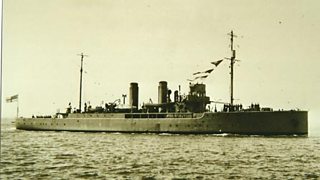On Easter Sunday 1943 (25 April), gale force winds and wild seas were lashing at the coast. Close to land, among the giant breakers and rolling waves of the storm, at the west Wales beach of Freshwater West a tragedy of monumental proportions was beginning to unfold.

The sloop 'Rosemary'. Six of her crew died while attempting a rescue of the men on LCG 16.
Two landing craft - Landing Craft Guns, or LCGs - were battered by the elements and, on the evening of what should have been a time of quiet contemplation, were sunk within sight of the shore. There were just three survivors.
Manned by Royal Navy personnel but carrying nearly 70 Royal Marines, the LCGs were unwieldy craft, ill designed to cope with such wild conditions. They had been built as LCTs (Landing Craft Tanks) but had been converted to LCGs ready for the planned invasion of Sicily in the Mediterranean.
Each of the two landing craft had been hurriedly fitted with 4.7 inch guns, weapons intended to attack Italian and German shore defences. More significantly, in order to quicken the conversion process, only part of the open deck of each craft - essential when carrying tanks, of no use whatsoever to a floating gun platform - had been covered in. It left almost half of the LCGs decks open to the elements. As Vernon Scott has written:
"A number of sailors and marines had jokingly suggested that if filled with water, this space would make an ideal swimming pool; others had expressed deep anxiety about the problems such a gap would cause in heavy seas."
Vernon Scott - An Experience Shared
LCG 15 and 16 had left Belfast, en route to Falmouth, a few days before. They had had no sea trials and it was intended to use the cruise to discover just how seaworthy the ships really were. The two craft docked briefly at Holyhead, and as they headed south across Cardigan Bay the weather began to deteriorate alarmingly.
Faced by mountainous seas and already shipping water into their open decks, the LCGs sought permission to enter Fishguard Harbour and then Milford Haven. For some inexplicable reason permission was refused and the landing craft had no option but to proceed on their way. By the time they arrived off Freshwater West they were in serious difficulty.
Angle lifeboat was undergoing repair and could not be launched but the crew, along with Angle Lifesaving Company and men from nearby Angle Aerodrome, rushed to the beach and cliff top at Freshwater West. They were helpless as the wind and waves were too strong for them to do anything but watch the tragedy unfold.
Within sight of the beach LCG 15 was overwhelmed and disappeared under the waves. Her companion vessel sank later in the night.
Marines and sailors were pitched into the cold, dark sea. Many of them were drowned; others were battered to death against the rocks on this part of the coast. Seventy-two young servicemen from the landing craft were killed in what was the worst maritime disaster, not involving enemy ships, of the whole war. Over 50 bodies were pulled from the sea but many were never recovered.
As if that wasn't enough, further tragedy was waiting in the wings that night. The old sloop HMS Rosemary was returning to Milford Haven after escorting a convoy to Scotland when she was ordered to the scene of the disaster. LCG 16 was spotted just off St Ann's Head at the entrance to the Haven and the men on board, clearly thinking that rescue was at hand, began to wave and leap about.
The weather was now so bad that it was impossible to get a line across to the stricken landing craft and, in desperation, the captain of HMS Rosemary asked for volunteers to launch and then man the ship's tiny whaler. That, it was felt, was the best chance of getting a line across and taking the LCG in tow.
Without thought of their own safety, six men immediately volunteered. The boat was launched and was soon lost to view in the crashing seas. Soon afterwards it was engulfed and swamped by a huge wave. All six crewmen drowned. Soon afterwards LCG 16 also sank.
It was later said that attempting to launch a small boat such as a whaler in seas like that was simply inviting disaster but, at the time, the primary aim of the Rosemary's captain and crew was to save the men on LCG 16. Emotions were running high and the sloop's crew could hear and see the panic of the men on the landing craft.
Quite why the LCGs had been refused permission to enter Fishguard and Milford Haven has never been fully explained. There was an inquiry but, with the war still raging, it was something of a cover up and no-one has ever been called to account for a decision that cost over 70 young lives.
Perhaps more inexplicable is the reasoning behind allowing the two landing craft to take to sea with their decks partially open to the elements. As all sailors who saw the conversions quickly realised, in anything like a heavy sea the LCGs would be little more than death traps. And yet they were allowed to sail across what has always been recognised as one of the most dangerous stretches of water around the British Isles.
In the wake of the disaster a memorial was erected high up on the dunes above Freshwater West beach. When compared to the value of human life it isn't much but it stands as a testimony to the tragedy that took place a few hundred yards off shore on Easter Sunday 1943.
